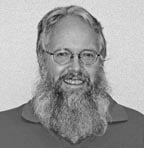The Nudist Camp in La Tuna Canyon

of the Crescenta Valley and loves local history. Reach him at
lawlerdad@yahoo.com.
One of the first nudist camps in the U.S., dating back into the 1930s, had its home close to CV, just over the Verdugos in La Tuna Canyon. In 1934, pioneers in the phenomenon of social nudism, Hobart and Lura Glassey, established one of the first nudist camps in the U.S. in Orange County near Lake Elsinore. It was a business, with paying members having access to a private campground. They had quick success, particularly after a widely circulated movie about nudism was filmed there. In 1935, with Lura’s pregnancy they opted to move closer to medical facilities, and purchased land in Roscoe (now Sun Valley) for a new nudist camp.
The new facility, Fraternity Elysia, was located at 9804 La Tuna Canyon Road in a little canyon on the south side of the road. That small canyon today is the site of a newer housing development at the intersection of La Tuna Canyon and Morning Glow Road.
The camp was a hit, and this new nudist colony was once again the setting for a nudist movie, 1938’s “The Unashamed,” which enjoyed a wide theater showing. A famous member of Elysium Fraternity was Caltech seismologist and Pasadena resident Charles Richter, namesake of the Richter scale that we use to measure earthquakes. He and his wife were nudists and were members of Fraternity Elysia from its beginnings in 1935, the same year that the Richter scale became the standard measure of earthquake intensity.
Although the camp was wildly successful, tragedy seemed to follow Fraternity Elysia. Hobart Glassey died tragically at Elysia in 1938 in a fall that broke his neck. In 1939, actress Dawn Hope Noel, daughter of a famous film and stage actress Adele Blood committed suicide at Elysia. This supposed evidence of the corruption of mind caused by nudism caused a storm of negative publicity for the camp and for nudism in general.
By the ’40s, the local authorities decided Fraternity Elysia was a liability to the morals of Los Angeles and began a series of raids on the camp. The now widowed Lura Glassey was arrested numerous times before WWII on oddball charges such as “allowing men and women to mingle while nude.” The camp, which had no neighbors and thus no one to offend, was staked out by officers who would observe through binoculars. They even produced a two-minute film to show in court. The film was taken through a telephoto lens from surrounding hillsides, and showed men, women and children sunbathing nude and semi-nude around a swimming pool. The charges never amounted to more than fines and probation, and WWII gave the police more important things to do.
When the war ended, the LAPD could once more take a bead on Fraternity Elysia and the arrest that spelled the end of the camp took place in 1946. Two members of the Vice Squad, a male and female officer, posed as nudists and applied for membership to the nudist camp. On a tour of the camp they observed “a score of persons including two young girls and four boys” playing badminton, ping pong and sunbathing in the nude at the camp. When two more officers showed up, someone yelled, “The coppers are here!” and everyone quickly put their clothes back on. However Lura Glassey and her new business partner Henry Broening were arrested and charged with violating the city’s new anti-nudity ordinance. They were convicted in a jury trial and sentenced to several months in jail. Broening chose to serve his sentence and be done with it, but Lura Glassey appealed the verdict.
With the help of the ACLU, she appealed to the Supreme Court, arguing that “nudism is a social belief, and not legally limited unless there is a danger to society.” But in Glassey v. State, 1947: “The Supreme Court ruled that the appellants had not demonstrated that the ordinance unduly restricted personal liberties. The original decision stood.”
Lura Glassy went to jail, while the nudist camp in La Tuna Canyon closed and became an interesting side-note of our local lore.
